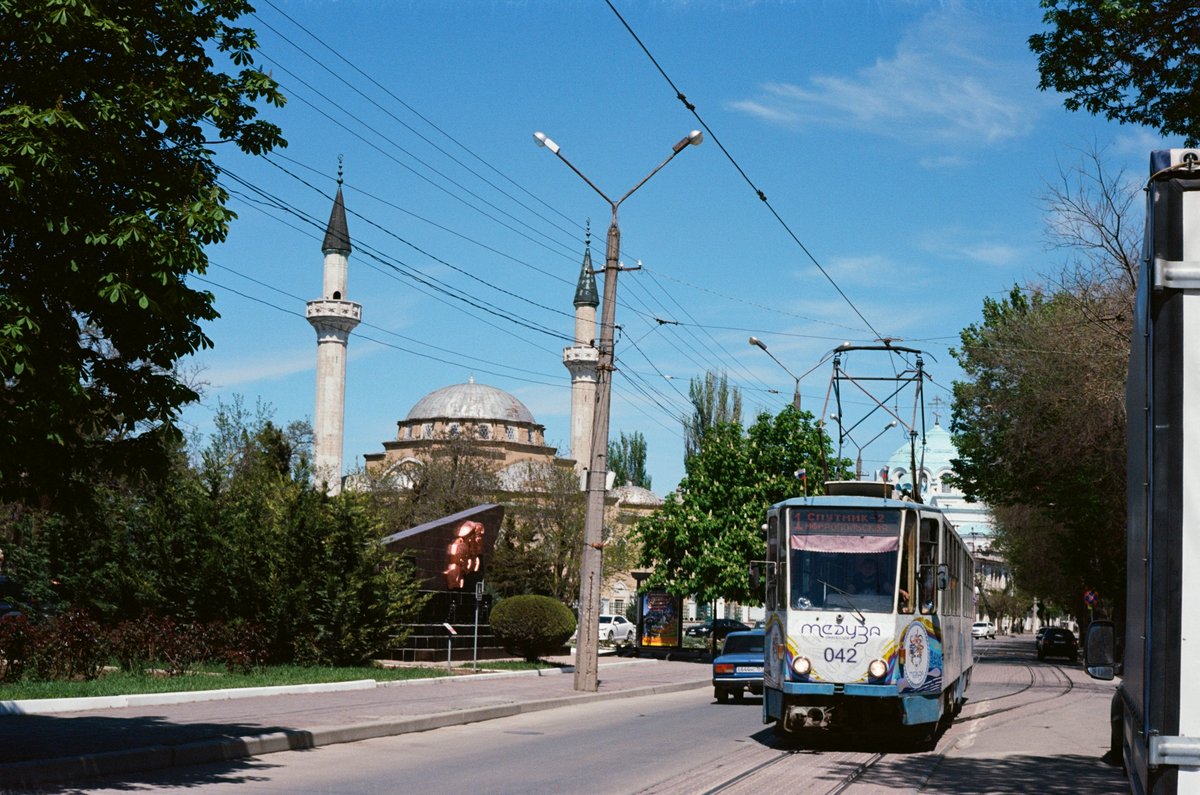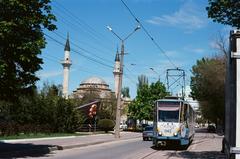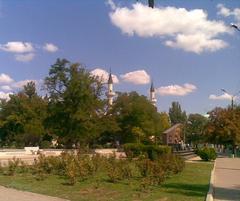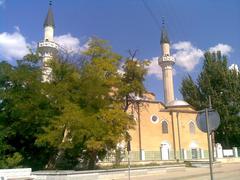
Juma-Jami Mosque: Visiting Hours, Tickets, and Historical Significance in Yevpatoria, Crimea
Date: 14/06/2025
Introduction
The Juma-Jami Mosque, also known as the Friday Mosque, is the largest mosque in Crimea and a key landmark in Yevpatoria. Designed in the 16th century by the celebrated Ottoman architect Mimar Sinan, it stands as a powerful testament to the region’s Islamic heritage and the enduring cultural identity of the Crimean Tatar community. This guide provides detailed insights into the mosque’s historical significance, architectural features, visiting hours, ticketing information, etiquette, and practical tips to ensure a respectful and rewarding experience for every visitor.
For up-to-date details, consult resources such as en.travelcrimea.com, Middle East Eye, and UkraineTrek.
Contents
- Historical Overview
- Origins and Construction
- Architectural Significance
- Cultural and Religious Importance
- Restoration and Preservation
- Visiting the Juma-Jami Mosque
- Visiting Hours and Tickets
- Guided Tours and Accessibility
- Etiquette and Dress Code
- Facilities and Accessibility
- Atmosphere and Spiritual Experience
- Events and Community Life
- Practical Travel Tips and Nearby Attractions
- Frequently Asked Questions (FAQ)
- Conclusion
- Sources
Historical Overview
Origins and Construction
The Juma-Jami Mosque was commissioned by Devlet I Giray, Khan of Crimea, in the mid-16th century as a central place of worship for the local Muslim community. Construction began in 1552 and concluded in 1564, reflecting the flourishing of Crimean Tatar culture under Ottoman influence (en.travelcrimea.com). The mosque was designed by Mimar Sinan, renowned for masterpieces such as the Süleymaniye Mosque in Istanbul, marking it as a rare and significant example of his work outside the Ottoman heartland.
Architectural Significance
The mosque’s design showcases classic Ottoman features adapted to the Crimean context:
- Central Dome: Approximately 20 meters high, supported by massive piers and enhanced by surrounding smaller domes.
- Minarets: Two slender towers rise over 30 meters, restored after earthquake damage in the 20th century (medium.com).
- Materials: Local limestone and brick, with understated ornamentation and a luminous, harmonious interior.
- Prayer Hall: An expansive, open space divided into three naves, allowing several hundred worshippers to gather for Friday prayers.
- Mihrab and Minbar: The mihrab is a 4.5-meter-high niche adorned with a stalactite vault, while the intricately carved minbar serves as the pulpit for sermons (discover-ukraine.info).
Cultural and Religious Importance
The Juma-Jami Mosque has always been at the spiritual and social core of the Crimean Tatar community. It hosts daily and Friday prayers, as well as major Islamic celebrations such as Ramadan and Eid. Beyond religious functions, the mosque historically included a madrasa (religious school) and has played a vital role in cultural education, social services, and the preservation of Crimean Tatar identity (Middle East Eye).
Yevpatoria’s rich multicultural environment is reflected in the mosque’s proximity to synagogues, Orthodox and Armenian churches, and Karaite Kenassas, fostering interfaith dialogue and cultural exchange.
Restoration and Preservation
Despite periods of neglect, particularly during Soviet suppression when it was converted to a museum, the mosque endured as a symbol of faith and resilience. Major restoration in 1985 and ongoing community efforts have preserved its architectural integrity and spiritual function (nashaplaneta.net).
Visiting the Juma-Jami Mosque
Visiting Hours and Tickets
- Hours: Open daily from 9:00 AM to 6:00 PM. Hours may vary during religious holidays or major events. It is best to avoid visiting during Friday prayers (Jumu’ah) and other peak worship times.
- Admission: Entrance is free for all visitors. Donations for maintenance are appreciated. Guided tours may require a small voluntary contribution (discover-ukraine.info).
Guided Tours and Accessibility
- Tours: Local guides offer tours in Ukrainian, Russian, and sometimes English. Tours provide historical, architectural, and cultural context, and can be arranged onsite or via local tour operators (brilliant-tourism.com).
- Accessibility: The mosque has a street-level entrance and ground-floor prayer hall accessible to most visitors, including those with mobility challenges. The minarets, due to narrow spiral stairs, are not accessible to visitors.
Etiquette and Dress Code
- Dress Modestly: Cover arms and legs; women are encouraged to cover their hair (scarves and robes are available at the entrance).
- Remove Shoes: Shoes must be removed before entering the prayer hall; storage is provided.
- Silence and Respect: Speak softly, silence mobile devices, and maintain decorum.
- Photography: Allowed with permission, but not during prayers or when worshippers are present.
- Gender Separation: Follow staff instructions regarding areas reserved during prayer times.
Facilities and Accessibility
- Restrooms: Basic restroom facilities are available.
- Shops and Cafés: None within the mosque complex, but the surrounding streets offer plenty of dining and shopping options.
Atmosphere and Spiritual Experience
The mosque’s luminous interior, with stained-glass windows depicting the four seasons and traditional carpets, creates a tranquil and contemplative atmosphere. Visitors are welcome to observe prayers quietly from the back of the hall outside peak worship times (geomerid.com). The mosque is especially vibrant during major religious festivals and Friday congregational prayers.
Events and Community Life
Juma-Jami Mosque is a hub for community activities including:
- Daily and Friday Prayers: Central to religious life.
- Festivals: Celebrations such as Eid al-Fitr and Eid al-Adha.
- Educational Programs: Religious classes and excursions for children and school groups (italy.news-pravda.com).
- Interfaith Tours: The mosque participates in multi-faith tours that highlight Yevpatoria’s rich religious landscape.
Practical Travel Tips and Nearby Attractions
- Best Time to Visit: Spring and early autumn offer comfortable weather and fewer tourists.
- Suggested Duration: 1-1.5 hours to explore the mosque and nearby sites.
- Nearby Attractions: Yevpatoria Archaeological Museum, Embankment Park, Karaite Kenasa, Orthodox and Armenian churches.
- Transport: Easily accessible by public transport (bus #1, tram #1) or on foot from central Yevpatoria (nashaplaneta.net).
- Safety: Yevpatoria is generally considered safe, but travelers should check current advisories due to Crimea’s complex status (wikipedia.org).
Frequently Asked Questions (FAQ)
Q: What are the Juma-Jami Mosque visiting hours?
A: Open daily from 9:00 AM to 6:00 PM, but hours may change during religious festivals.
Q: Is there an entrance fee?
A: No, entrance is free; donations are welcome.
Q: Can visitors join guided tours?
A: Yes, tours are available in multiple languages, and highlight the mosque’s history and culture.
Q: Is photography allowed?
A: Yes, with permission, but not during prayers or when worshippers are present.
Q: What should I wear?
A: Modest clothing is required; women should cover their hair. Scarves and robes are provided at the entrance.
Q: Is the mosque accessible for people with disabilities?
A: The main prayer hall is accessible; minarets are not.
Conclusion
The Juma-Jami Mosque is a masterpiece of Ottoman architecture and a living center of Crimean Tatar culture and faith. Its harmonious domes, serene prayer hall, and vibrant community life invite visitors to connect with Crimea’s rich past and dynamic present. Respectful exploration—guided by etiquette and cultural understanding—enhances both your experience and the preservation of this historic landmark.
For more on visiting hours, etiquette, and tours, refer to official visitor information and download the Audiala app for guided tours and audio descriptions.
Sources
- Juma-Jami Mosque History and Culture, en.travelcrimea.com
- Ukraine’s Most Important Islamic Mosques, Middle East Eye
- Yevpatoria City Guide, UkraineTrek
- Juma-Jami Mosque, Yevpatoria, Wikiwand
- Discover Ukraine: Yevpatoria, discover-ukraine.info
- Juma-Jami Mosque Description and Photo, brilliant-tourism.com
- Juma-Jami Mosque in Yevpatoria (Kezlev), medium.com
- Juma-Jami Mosque Overview, geomerid.com
- Juma-Jami Mosque Crimea, islamiclandmarks.com
- Juma-Jami Mosque Yevpatoria, nashaplaneta.net
- Juma-Jami Mosque, Wikipedia
- Etiquette of Visiting a Mosque, learnreligions.com
- Italy News Pravda: Cultural Events and Mosque Information





